There are no items in your cart
Add More
Add More
| Item Details | Price | ||
|---|---|---|---|
By Tony Das Published on: Wed Apr 20, 2022
For the pre-chorus, we use the chords B Minor, A Major, D Major, and G Major. The sequence is Bm-A-D-G-Bm-A-D-G-Bm-A-D. In the last part of this pre-chorus, we strum each of the chords (Bm, A, D) just once for contrast and a dip before it builds into the chorus. For the bridge section, we play F-Bb-C-Bb-F-Bb-C-C.

A celebrated guitarist who has performed with well-known bands for two decades, your teacher is a professional musician who has played at some of the biggest music festivals in India, and toured the UK and the Gulf as well. As a guitarist, bassist and singer, he has worked on several film scores and movie songs.
In the previous blog post, we looked at the intro riff for the song “Summer of ’69” by Bryan Adams. Now, we will continue learning how to play the remaining parts of the song. The use of this particular song is purely for educational purposes, so you get comfortable with playing chords for popular songs.
After the intro riff and the D sus2 / D Major followed by A sus2 / A Major portion, we move to a section that we could call the pre-chorus. Here we use the chords B Minor (Bm), A Major (A), D Major (D), and G Major (G).
The sequence for the pre-chorus is: Bm-A-D-G-Bm-A-D-G-Bm-A-D. One thing to note here, is regarding the last part of this pre-chorus where the singer says “Those were the best days of my life”. Here we strum each of the chords (Bm, A, D) just once for contrast, and a dip before it builds into the chorus. Remember, if we don’t write Major/Minor/etc. after a chord name, we mean that it is a Major chord by default.
For the chorus, we use the chords D and A, alternating between the two. There are two ways to play this section of the song, as outlined below. One is a more rhythmic version, while the other is a more sustained-chord version.
Chorus – More Rhythmic Version


Chorus – More Sustained-Chord Version


D = Downstroke | PM = Palm Muting | > = Accent (remove the palm to unmute) | --- = Continue palm muting
During this section of the song, there’s a part that gets played on the keyboard for accompaniment. This can be played on the guitar as well, using chord arpeggios – a technique you have read and learnt in previous blog posts. The chords to be used are Dsus2, D, and Dsus4.
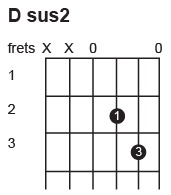


Dsus2: Index finger on the 2nd fret (3rd string), ring finger on the 3rd fret (2nd string), and open strings (1st and 4th string).
Dsus4: Index finger on the 2nd fret (3rd string), ring finger on the 3rd fret (2nd string), little finger on the 3rd fret (1st string), and open string (4th string).
Dsus4: Index finger on the 2nd fret (3rd string), ring finger on the 3rd fret (2nd string), little finger on the 3rd fret (1st string), and open string (4th string).
The arpeggiated chord sequence is: Dsus2 (strings 1-2-3), D Major (strings 1-2-3), Dsus4 (strings 1-2-3), back to D Major (strings 1-2-3), Dsus2 (strings 1 and 3), and finally D Major (strings 1 and 3).
Next, we use the chords Asus2, A, and Asus4 as an arpeggio to substitute for the keyboard backing.
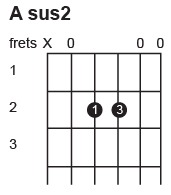
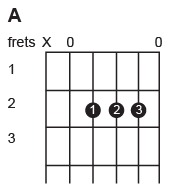
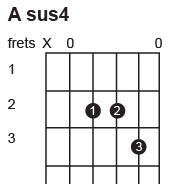
Asus2: Index finger on the 2nd fret (4th string), middle finger on the 2nd fret (3rd string), and open strings (1st, 2nd and 5th).
Asus4: Index finger on the 2nd fret (4th string), middle finger on the 2nd fret (3rd string), ring finger on the 3rd fret (2nd string), and open strings (1st and 5th).
The arpeggiated chord sequence is: Asus2 (strings 2-3-4), A Major (strings 2-3-4), Asus4 (strings 2-3-4), back to A Major (strings 2-3-4), Asus2 (strings 2 and 4), and finally A Major (strings 2 and 4).
After the chord arpeggios, we have a second verse which is basically a repeat of the first verse using chords D and A. We then go back to the pre-chorus with chords Bm, A, D, and G. There’s also a bridge section which goes outside the key of D.
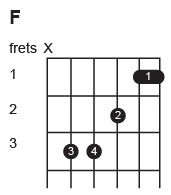
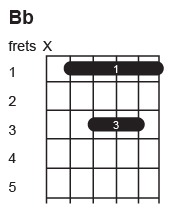
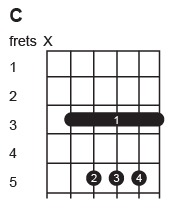
F Major: Index finger on the 1st fret (1st and 2nd string), middle finger on the 2nd fret (3rd string), ring finger on the 3rd fret (5th string), and little finger on the 3rd fret (4th string).
Bb: Index finger on the 1st fret (strings 1 to 5), and ring finger on the 3rd fret (strings 2 to 4).
C Major: Index finger on the 3rd fret (strings 1 to 5), middle finger on the 5th fret (4th string), ring finger on the 5th fret (3rd string), and little finger on the 5th fret (2nd string).
We play F-Bb-C-Bb-F-Bb-C-C with the rhythm 1&2&3&4& for this bridge section. Bb and C are the essentially the same shape, but here you would see two ways of playing them, depending on which you find more comfortable. Bb requires you to flatten your 3rd finger across the D, G, and B strings, whereas C requires you to use separate fingers for each of those strings.
This leads back to the riff we learnt earlier with Dsus2, D, Dsus4 and Asus2, A, Asus4. This is followed by another verse which repeats, then there’s the pre-chorus same as before, a chorus which continues a number of times, and a guitar solo which fades out to exit from the song.
This may not sound identical to the album version as we have adapted it so you can play on the acoustic guitar as well, without having a full band play along with you. These rhythms are put together from various versions of the song, in order to make your playing experience on the acoustic guitar a little more interesting.
All the techniques from earlier that we incorporated to play this fun song can be applied to different kinds of music, in many different styles. Read both this and the previous post, practise both parts of the song individually first, and then combine the two to play “Summer of ‘69” by Bryan Adams.
Wasn’t that a fun exercise? We’ve got more practical exercises and popular songs lined up in upcoming blog posts. Keep reading, practising, learning and improving as an aspiring guitarist.